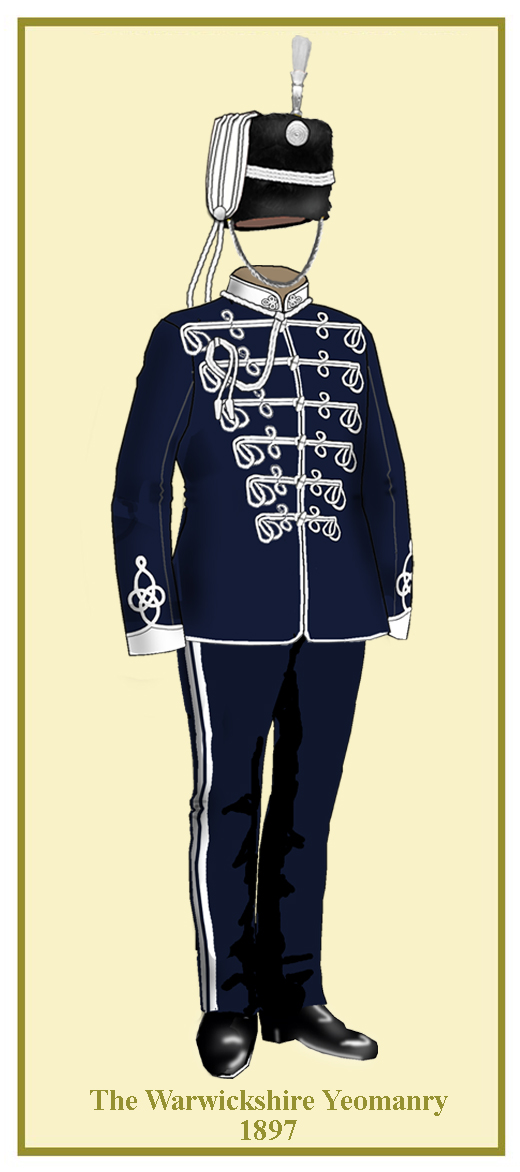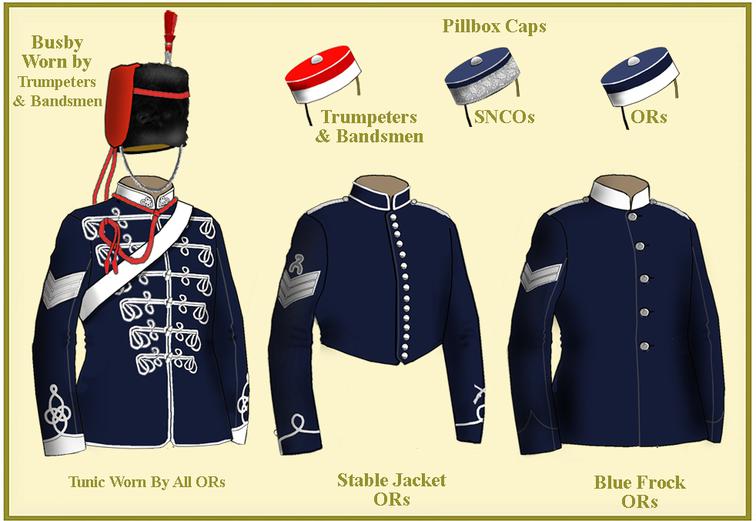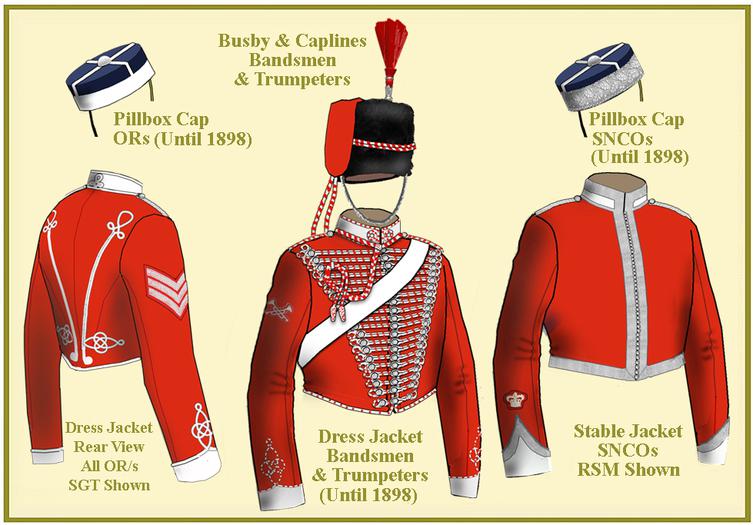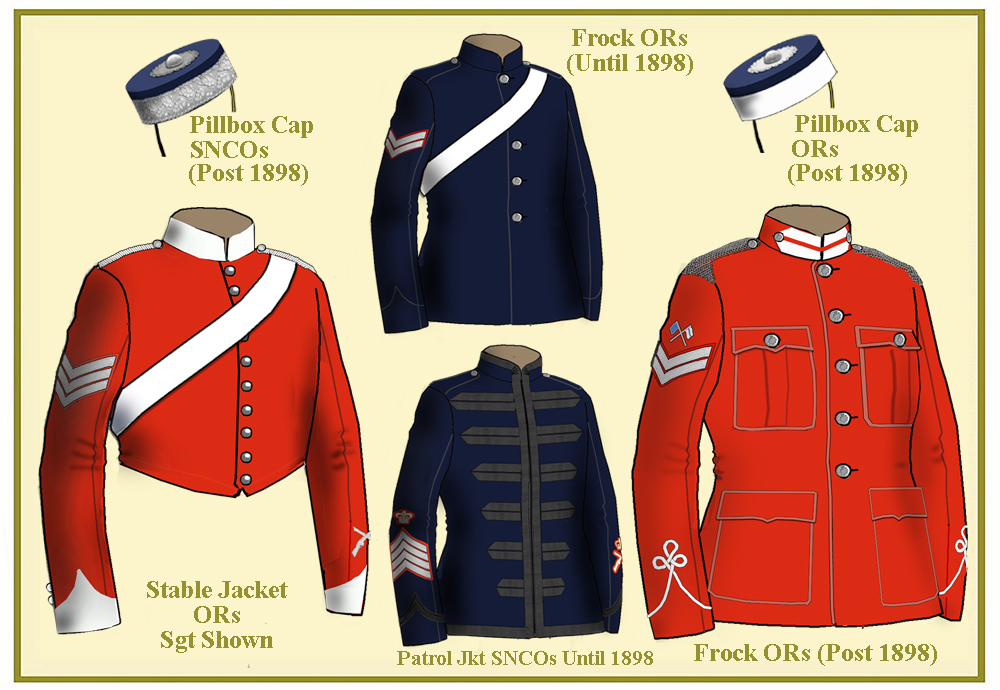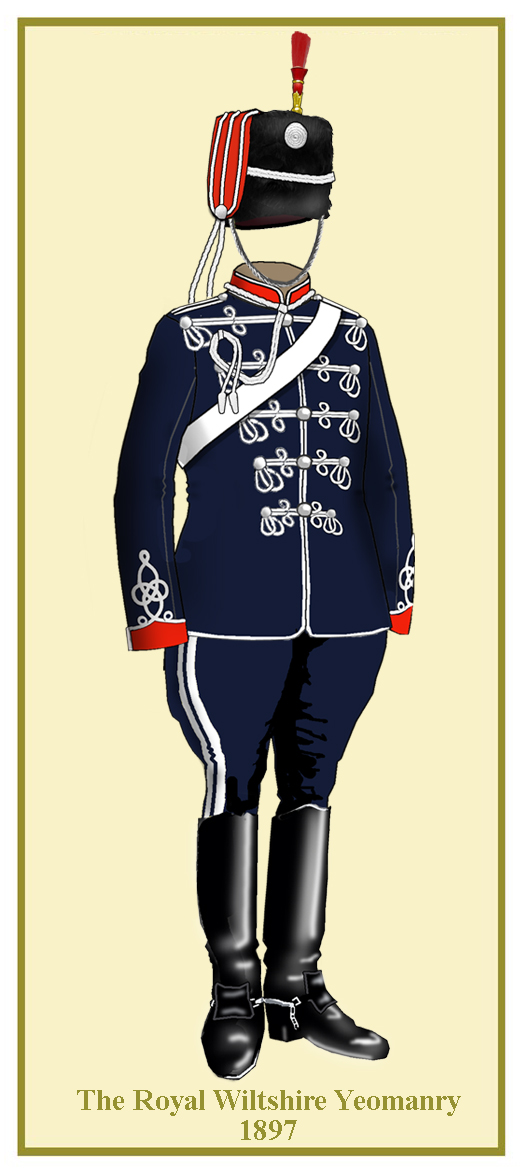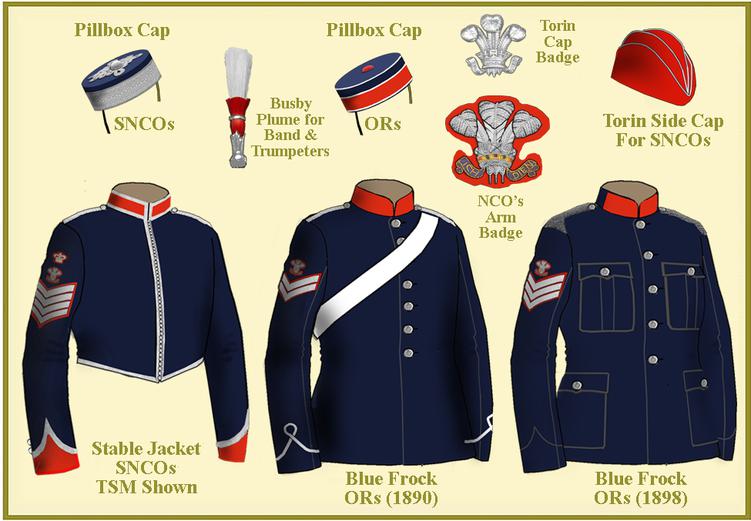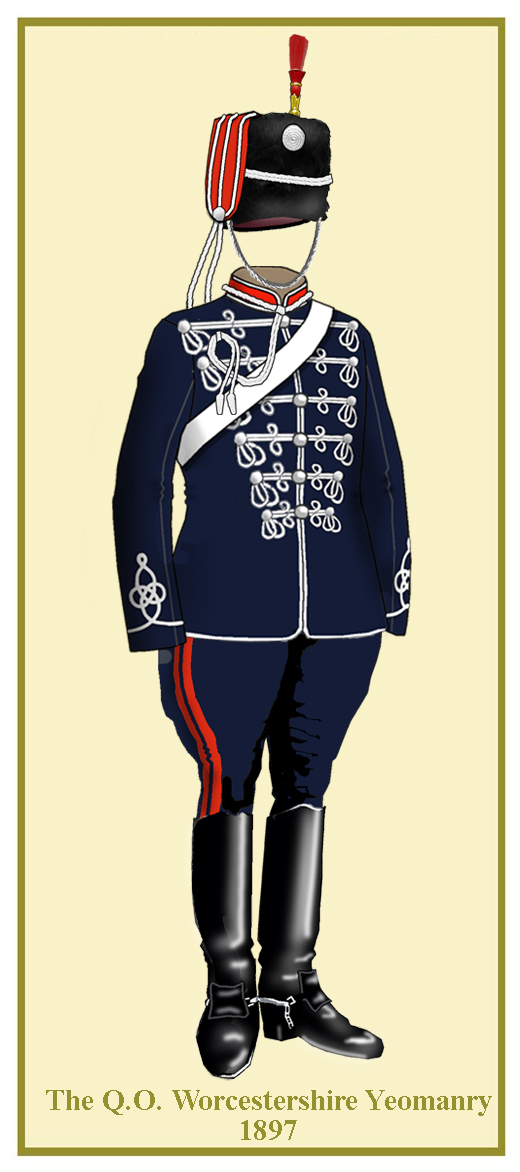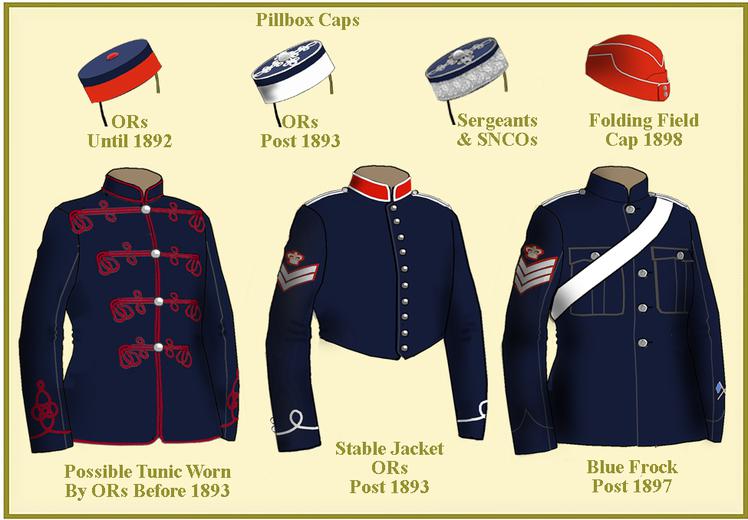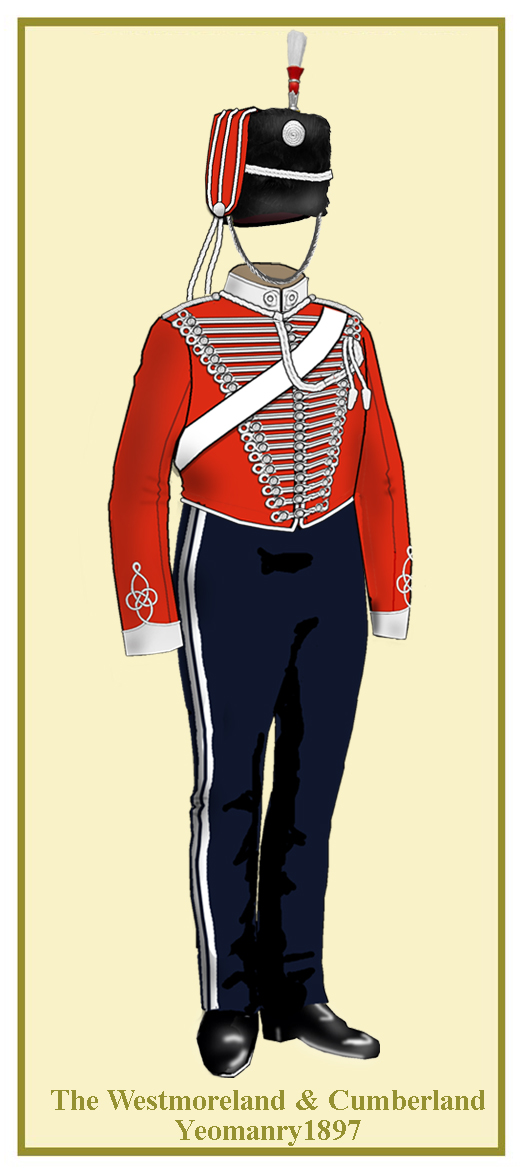The Warwickshire Yeomanry
Ranked No. 2 in Yeomanry Order of preference
Four troops were raised in 1794 from Packington, Aston, Rugby and Kineton. These troops were regimented as the Warwickshire Yeomanry in 1797 and later augmented by troops from throughout the county. Some of these troops were disbanded in 1802 and re-raised a year later but only five remained by 1830. In 1831 a 6th troop was added and for the next few years the regiment dealt with civil unrest, mostly in Birmingham. With the addition of two more troops in 1854 the history of the Warwickshire Yeomanry followed the normal path to the end of the century.
Formed 5th Coy of 2nd Bn Imperial Yeomanry in 1900
UNIFORMS OF THE BRITISH YEOMANRY REGIMENTS 1895-1900
PART 9
Uniforms
There is little in the way of hard evidence about what the various troops of Warwickshire Yeomanry wore when raised. A portrait and some anecdotal notes suggest that when regimented, they wore light blue (or French Grey) jackets with mid green facings. Willson’s 1806 chart says that all troops wore scarlet with yellow facings, but this may have excluded the Warwickshire corps itself. By 1810 the uniform was almost definitely French grey with green facings. The jacket appears to have had three rows of brass buttons with white lace across the front. White breeches were worn and the Tarleton helmet had a green turban and black crest. If there was a plume, it was not mentioned. An 1822 watercolour shows a trooper in the same French grey jacket with green facings and the same colour overalls with a broad green stripe. The headdress was now a bell topped shako with white over red plume and an indistinct brass badge. There was a yellow band around the top.
A complete uniform change took place in 1833. The jacket, of the double breasted light dragoon style, was scarlet with white collar and cuffs, the latter with rectangular white flaps with four or five buttons. All lace and buttons were white metal. White metal epaulette scales were worn (without fringes). A yellow girdle with two scarlet stripes was worn around the waist. Overalls were dark blue with double red stripes and the headdress was an 1830 pattern black felt bell topped shako with white lace around the top and a brass eight pointed star on the front with the Royal cypher in the centre and a crown on the lace band above. The plume was white drooping horsehair and the cap lines were yellow.
In 1857 another major uniform change took place. The regiment now took a dark blue tunic with white collar and cuffs into wear which was of the current light dragoon pattern. However, despite being edged all round with white cord and with Austrian knots on the sleeves, there was no lace frogging on the front and the tunic was fastened by hooks and eyes. The blue overalls now had double white stripes instead of red and an Albert pattern shako had replaced the previous one but retained the badge and drooping white plume. There was a thinner white lace band around the top and the cap lines were also now white. These shakos were replaced by busbies in 1863. These were of regulation pattern with white bags, lace and caplines and a white cord boss in front. The brush plume was white over white in a white metal socket. In 1867 six loops of hussar lace were added to the front of the tunic. These loops and rear braiding were the same as for regular hussars (in white instead of yellow) except for some unique differences. There were no caps (domed cord buttons) over the drops on the ends of the loops, the front of the collar was decorated with white cord trefoils on each side and there were no shoulder cords. The tunic was fastened with olivets.
New pattern busbies were adopted in 1890 ( for a while the cap lines looped three times around the busby)and pantaloons with double white stripes and knee boots were issued some time before that. NCOs wore silver lace chevrons on a white background. The band wore similar uniforms except that the busby plume, busby bag and caplines were red. These appeared in the 1880s and the band wore the 1857 busbies until about 1900 when they were in the process of being withdrawn.
Stable jackets were blue with white piping on the collar and loops on the cuffs which were silver for SNCOs. There were 12 to 14 buttons down the front. Pillbox caps were blue with white band, crown piping and button, while NCOs had silver, the band being of oak leaf pattern. The band and trumpeters may have had red pillboxes. In 1897 the men were issued with blue five button frocks with white collars and shoulder cords. This was replaced with a version with patch pockets in 1901.
Post Boer War the regiment went into khaki with slouch hats which were plain and unembellished until 1907 when ORs received white trefoil loops on the cuffs. Full dress was never completely withdrawn and a staff pattern peaked cap was adopted in 1908. This was white with a blue band and blue top although busbies were again issued when the regiment wore full dress at the 1911 coronation.
The Westmorland and Cumberland Yeomanry
Ranked No. 17 in Yeomanry Order of preference
The Westmorland Yeomanry Cavalry was formed in 1819 and by 1828 had six troops (including three from Cumberland). From the beginning, it was used to control civil disorder which remained the regiment’s focus for more than twenty years. In 1843 it officially became the Westmorland and Cumberland Yeomanry. The regiment was raised by the Henry Cecil Lowther (The Earl of Lonsdale) and was closely associated with that family and the Hasells for its entire existence
Formed 24th Coy of the 8th Bn Imperial Yeomanry in 1900
Uniforms
This regiment was one of the few whose uniforms remained relatively the same from its raising until the end of the century. An account of the time describes the uniform as having scarlet jackets and “Skiddaw” grey trousers with hats that looked “like frying pans”. (Probably referring to a shako!). By 1830 the regiment was dressed as hussars with a scarlet jackets laced with white cords across the chest, white collars and pointed cuffs, blue trousers with a white stripe and black shakos with a black plume. The shako was laced at top and bottom with white tape and the badge was a brass garter star on a pinwheel. Barreled sashes, like the gold and crimson ones used by officers were probably worn with yellow replacing the gold. An unusual feature was white gauntlets worn by all ranks including officers. Not an item usually associated with hussars. Pelisses were not worn by any ranks at this time. Shortly before 1857 brown busbies with red bags and white over white plumes had replaced the shakos. Later the overalls had double white stripes. Barreled sashes were no longer worn by other ranks after 1869. In 1873 the gauntlets were finally abolished and replaced with white wrist gloves (although officers appear to have worn them for a year or so afterward).
From 1880 a gradual modernisation took place beginning with the issuing of knee boots and pantaloons, the overalls reserved for dismounted parades and barrack wear. When the 5th Earl of Lonsdale became colonel in 1897, he instituted some changes, mostly with officer’s uniforms but he did have the 1857 busby replaced by a black 1888 version along with braiding and button on the bag and a boss beneath the plume holder. The caplines were looped up to the left shoulder but by 1899 had been moved to the right. NCO’s rank badges were silver on a red backing.
The band’s uniform was the same as the rest of the regiment with the exception that all the white lace on the jacket and the busby lines had red speckles. The band did not receive pantaloons and knee boots until 1895 and the 1857 busby with full red plume did not change for a few years after the rest of the regiment. One of the Earl of Lonsdale’s changes was to add yellow flecking to the bandsmen’s lace which may not have been carried out fully before the regiment became Imperial Yeomanry.
Stable jackets were scarlet with white collar and cuffs with SNCOs having silver lace around the collar, down the front and bottom edge and above the cuffs. Recognizing that the full dress jackets were unsuitable for field work, a plain blue frock with five buttons was introduced in 1893. This was replaced with a scarlet frock in 1898 which had patch pockets and shoulder chains. The collar had white pointed gorget patches with red cords and silver buttons and the cuffs had white trefoil cords. Senior NCOs wore patrol jackets with black mohair edging and five loops across the front until replaced by the scarlet frock. Until 1898 the pillbox caps were blue with white bands, buttons and white lancer quartering on the top. NCOs and above had the same with silver lace. When discontinued the quartering was replaced by figuring on the crown.
Upon their return from South Africa, The scarlet frock was retained along with the old full dress for special parades. In 1902 a khaki service dress was worn until 1905. This had a white collar and white trefoils on the cuffs. A khaki slouch hat was worn as well as the blue pillbox with white band. Although the full dress was replaced in 1905 by the scarlet frock, it was reintroduced in 1908 without the busby. In 1911 it was worn with a scarlet staff pattern cap with white band and crown piping.
The Royal Wiltshire Yeomanry (Prince of Wales's Own)
Ranked No. 1 in Yeomanry Order of preference
The ten troops raised in 1794 were regimented as the Regiment of Wiltshire Yeomanry Cavalry in 1797. Because of this and their continuous service since they were established, they became the senior Yeomanry corps and first in order of preference. Thus they received the prefix “Royal” from King William IV in 1831 and because they escorted His Royal Highness in 1860 they were awarded the title “Prince of Wales’s Own” in 1863. Prior to 1850 they had been involved in the usual but arduous task of dealing with civil disobedience. From 1860 they had a mounted rifle section which was disbanded about 15 years later.
Formed 1st, 2nd & 63rd Coys of 1st Bn Imperial Yeomanry in 1900
Uniforms
Blue uniforms with scarlet facings characterized the regiment from its inception. By 1803 they wore the standard light dragoon uniform of blue jacket with three rows of yellow metal buttons as well as scarlet collar, cuffs and piping. White breeches and knee boots were worn with the Tarleton helmet which had a black crest and turban with brass chains. Above the turban on the right was a triangular brass plate with a crown above and the GR cypher on the plate. There was a white plume on the left. This uniform was worn until 1830 by other ranks except that the Tarleton helmet was exchanged for a bell topped shako in 1820 and grey overalls were introduced. (From 1820, officers had an elaborately laced uniform coat). The jacket became like the regular light dragoon one with a double row of buttons in 1831 and the 1830 pattern shako was taken into wear which was in turn replaced by the Albert pattern shako in 1847.
In 1858 the regiment adopted the current light dragoon uniform of 1856 but changed its lace from gold to silver (white for other ranks). The tunic was dark blue with scarlet collar and cuffs with five loops across the front fastened with ball buttons, white shoulder cords and lacing on the rear. The Austrian knots on the cuffs had extra dragoon eyes and the cord followed down the rear seam of the cuff. The overalls had double white stripes. The light dragoon shako was dark blue cloth with a scarlet drooping plume and a silver Maltese cross badge. This was exchanged for a shorter infantry style kepi in 1870 with scarlet brush plume. From 1863 as a result of the Prince of Wales’s honour, his badge was used on badges and officers pouches and sabretaches. In 1883 it was adopted as an NCOs arm badge. The uniform of the mounted rifle section appears to have consisted of a blue nine button infantry tunic with scarlet collar and cuffs with white piping around the collar and down the front and on the rear skirt seams. There were Austrian knots on the cuffs with extra eyes like those on the Hussar jacket and a ¼ inch piping down the trouser seams. The kepi was the same as in the rest of the regiment.
In 1880 pantaloons with knee boots were taken into wear and the kepi was replaced by the 1857 busby whose caplines were not wound around the busby. When the 1888 pattern busby was introduced in the mid-nineties, the caplines were worn conventionally with the tassels looped on the right breast. From 1893 orders were issued to add another loop to the frogging in line with regular hussars (officers had already changed to six loops) but few troops had done so by the end of the century although the contingent sent to Australia and New Zealand in 1901 appear to have had six loop tunics. NCO chevrons and badges were silver on red backings and the Prince of Wales’s badge was of silver embroidery on red backing.
The stable jacket followed conventional fashion of blue with scarlet collar and pointed cuffs. SNCOs had narrow silver lace bordering the jacket and on the collar and cuffs. A blue seven button frock was issued in the 1890s which had a red collar and a single loop of white lace on the cuffs. The stable jacket was phased out from this time. In 1898 a five button frock with pockets was introduced which had red collar patches and shoulder chains. The pillbox cap was blue with a scarlet band with white piping above and below the band and on the crown edge. The button was red. NCOs had silver oak leaf band, silver piping and figure on the top. In the mid-90s SNCOs had scarlet Torin caps with the Prince of Wales’s badge in silver.
In 1902 the hussar uniforms were discontinued but the regiment retained their blue frocks with the addition of collar badges. Instead of knee boots, blue puttees were worn and the headdress was a khaki colonial pattern helmet with khaki puggaree. A photo of the kettledrummer in 1903 shows a puggaree with scarlet vandyking but it is not known whether the entire band wore this. A blue staff pattern cap with scarlet crown piping was issued in 1905, often worn with a white cover. In 1907 plain khaki uniforms with khaki peaked caps were introduced. At the 1911 coronation they apparently wore the blue frock with scarlet collar patches, blue overalls with white stripes and the blue staff cap, although no photos exist.
The Queen's Own Worcestershire Hussars
Ranked No. 31 in Yeomanry Order of preference
The first troop was formed in Worcester in October of 1794 and by 1803 eight more troops were raised. At the conclusion of the Napoleonic Wars three troops remained in service which were disbanded in 1827. The continuation of public unrest in 1830 prompted the government to authorize the re-raising of many yeomanry units and Worcestershire formed eight troops which later became four squadrons. Edwin Hughes, the last survivor of the Charge of the Light Brigade served as an instructor of the regiment for many years. In recognition of their service during the Golden Jubilee of 1887, they were permitted to style themselves “The Queen’s Own Worcestershire Hussars”.
Formed 16th Coy of the 5th Bn Imperial Yeomanry in 1900
Uniforms
The first Worcester corps wore scarlet jackets with blue facings. The jacket fastened with a single row of 12 – 14 buttons and double loops of white lace went across the front. There were padded scarlet shoulder wings with white edging. Breeches were white with black knee boots and the Tarleton helmet had a black crest, leopard skin turban with white metal chains and white over red plume on the left side. The badge on the right side was a brass triangular plate with a crown above and scroll beneath inscribed “WORCESTERSHIRE” and brass scolls on the front, either side of the turban above the peak inscribed “YEOMANRY” on the right and “CAVALRY on the left. This uniform was worn up to disbandment in 1827 although the Tarleton helmet was replaced sometime before 1824 by a black bell topped shako of unknown description and probably overalls also without evidence.
Upon reformation in 1831 the regiment continued to wear scarlet jackets, this time in the contemporary light dragoon style with gold/yellow lace and two rows of brass buttons down the front. The facings were now yellowish buff on the collar and pointed cuffs, the collar had a thin loop of yellow braid and button. A yellow and red girdle was worn and there were brass shoulder scales. The trousers were dark blue with ½ inch red stripes. The black felt shako had a brass eight pointed star plate and was bound with black leather top and bottom. The plume was white. Farriers wore dark blue coatees with buff facings, a white cloth horseshoe on the right upper arm and a black plume. Trumpeters wore red plumes.
In 1838 the lace changed to silver/white on the uniform and shako which appeared to be less “belled” suggesting a new pattern. The tunic facings now became blue again and a double bar of white pointed gorget lace appeared on the collars. The shako plume remained white and the star plate bore the legend “Queen’s Own” above the garter and “Worcestershire Yeomanry” on the belt. The centre of the star now had the VR cypher. It should be mentioned here that the band wore a unique headdress until 1850. It consisted of a tall bearskin in white fur with a domed brass plate above the black peak. There was a drooping red plume coming out of a brass socket on the top front of the bearskin. In other respects the uniform appeared the same. In 1850, the shako was replaced by a black leather dragoon helmet (of a pattern earlier than the 1847 Albert helmet) with white metal fluted comb and front plate. The helmet was bound around the waist and on the front peak with white metal and the flowing horsehair plume was white over red.
As this uniform was worn until 1871, the Worcestershire Yeomanry may have been the last to wear the old coatee in full dress. A major change came in this year when the dark blue light dragoon tunic was taken into wear. For officers the four hussar loops across the front were silver lace and the tunics were edged all round with the ¾ inch silver check lace. The cuffs were heavily decorated according to rank above and below a silver lace chevron on each cuff. Overalls were blue with ¾ inch silver lace stripe.
The uniform for other ranks at this time is unknown except for a suggestion in a regimental history that the blue tunic had four crimson loops across the front and the edging was also crimson. Both officers and men wore an astrakhan busby similar to that worn at the time by rifle regiments (Or the East Kent Mounted Rifles). It had a red bag and the plume was red. The cap lines were white. The overalls were apparently the same as worn with the old uniform with the red stripes. Given the supposed crimson loops on the tunic, it appears that the uniform designers and tailors for the regiment were not slaves to fashion! In 1886 pantaloons with double scarlet stripes and knee boots were introduced. The Astrakhan busby was replaced in 1890 by the 1888 pattern hussar busby with scarlet bag with white lacing and button with white cap lines and red plume. In 1892 the contemporary hussar tunic was adopted with six loops and white metal dome buttons. The collar became scarlet and no cords were worn on the shoulders. The tunics of SNCOs down to sergeant had silver lacing instead of white and NCOs wore silver lace chevrons on scarlet backings while all corporals and above wore a crown as a regimental arm badge. The regiment’s appearance now coincided for the most part with most hussar dressed yeomanry units.
New stable jackets were introduced in 1892 which followed general hussar patterns. It was blue with scarlet collar piped white and white loops on the cuffs with 10 buttons down the front. This was replaced in 1898 by a plain blue five button frock with box pleated pockets on the chest and shoulder chains. Pill box caps which had been blue with red bands were in 1892 blue with white bands, top edge, dome button and looped figuring on the top. These features were silver for sergeants and SNCOs. In 1897 a contemporary folding field cap was introduced for all ranks. It was scarlet with white piping for other ranks but sergeants and above had silver piping on the flaps and top seams.
In 1902 the regiment adopted an attractive full dress uniform based on that of the New South Wales Lancers. It was khaki with scarlet plastron, collar and cuffs, breeches and overalls with double scarlet stripes and a khaki slouch hat with red plume and red top fold on the puggaree. When mounted, brown Stohwasser gaiters were worn. It apparently was not popular with the men however. For service dress the other ranks had khaki frocks with scarlet stand and fall collar with scarlet trefoils on the cuffs and tan breeches piped red. The slouch hat remained in use until 1907. In 1908 the hussar full dress was reintroduced and worn with a drummer’s red staff pattern peaked cap. For service dress, the regular army khaki kit and cap were worn. At the coronation of King George V, the unit turned out in the hussar uniform with red caps but now with white double stripes on the overalls.
Warwickshire Yeomanry
Westmoreland & Cumberland Yeomanry
Royal Wiltshire Yeomanry
Worcestershire Hussars



